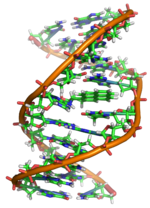IARC group 1 Carcinogens are substances, chemical mixtures, and exposure circumstances which have been classified as carcinogenic to humans by the International... 12 KB (1,194 words) - 21:53, 22 March 2024 |
Carcinogenic parasites are parasitic organisms that depend on other organisms (called hosts) for their survival, and cause cancer in such hosts. Three... 20 KB (2,277 words) - 13:40, 15 April 2024 |
The safe handling of carcinogens is the handling of cancer causing substances in a safe and responsible manner. Carcinogens are defined as 'a substance... 8 KB (930 words) - 22:16, 1 October 2023 |
IARC group 2B (redirect from IARC Group 2B carcinogen) exposure circumstances are those that have been classified as "possibly carcinogenic to humans" by the International Agency for Research on Cancer (IARC)... 15 KB (1,445 words) - 02:21, 14 February 2024 |
 | Cooking (redirect from Carcinogens in cooked food) avoidable by changes to the diet. Some of these cancers may be caused by carcinogens in food generated during the cooking process, although it is often difficult... 45 KB (4,940 words) - 19:48, 1 May 2024 |
A co-carcinogen is a chemical that promotes the effects of a carcinogen in the production of cancer. Usually, the term is used to refer to chemicals that... 10 KB (1,177 words) - 01:07, 27 September 2022 |
Anticarcinogen (redirect from Anti-carcinogenic) carcinopreventive agent) is a substance that counteracts the effects of a carcinogen or inhibits the development of cancer. Anticarcinogens are different from... 2 KB (174 words) - 14:54, 29 November 2021 |
IARC group 2A (redirect from IARC Group 2A carcinogen) carcinogens by the International Agency for Research on Cancer (IARC). This designation is applied when there is limited evidence of carcinogenicity in... 8 KB (740 words) - 02:20, 14 February 2024 |
Occupational cancer (redirect from Occupational carcinogen) cancer-causing chemicals (carcinogens) may cause mutations that allow cells to grow out of control, causing cancer. Carcinogens in the workplace may include... 18 KB (1,564 words) - 00:27, 27 April 2024 |
occurrence of cancer worldwide. Its IARC monographs programme identifies carcinogenic hazards and evaluates environmental causes of cancer in humans. IARC... 28 KB (2,978 words) - 21:52, 22 March 2024 |
IARC group 3 (redirect from IARC Group 3 carcinogen) circumstances are those that can not be classified in regard to their carcinogenicity to humans by the International Agency for Research on Cancer (IARC)... 17 KB (1,536 words) - 22:22, 22 March 2024 |
 | DNA adduct (section Carcinogens' impact) an organism's exposure to a carcinogen. The presence of such an adduct indicates prior exposure to a potential carcinogen, but it does not necessarily... 18 KB (2,160 words) - 20:34, 19 January 2024 |
 | Formaldehyde (category IARC Group 1 carcinogens) Small amounts also occur naturally. Formaldehyde is classified as a carcinogen and can cause respiratory and skin irritation upon exposure. Formaldehyde... 88 KB (8,177 words) - 12:36, 25 April 2024 |
Acrylamide (category IARC Group 2A carcinogens) following its discovery in 2002, and its possible classification as a carcinogen, acrylamide from diet is thought unlikely to cause cancer in humans; Cancer... 22 KB (2,035 words) - 00:26, 21 January 2024 |
Decemberunderground (redirect from Carcinogen Crush) originally planned for December 2007, but which never materialized. "Carcinogen Crush", written by Burgan, was first recorded during the Sing the Sorrow... 37 KB (2,712 words) - 17:48, 3 April 2024 |
 | Arsenic (category IARC Group 1 carcinogens) Hazardous Substances at Superfund sites. Arsenic is classified as a Group-A carcinogen. The three most common arsenic allotropes are grey, yellow, and black... 133 KB (14,394 words) - 06:04, 6 May 2024 |
 | Gasoline (redirect from Carcinogens in gasoline) production, handling, transport and delivery. Gasoline contains known carcinogens. Gasoline is often used as a recreational inhalant and can be harmful... 156 KB (17,613 words) - 08:35, 6 May 2024 |
 | carcinogen in the United States Environmental Protection Agency Office of Pesticide Programs carcinogen list with a rating of C (possible carcinogen)... 4 KB (198 words) - 14:27, 21 December 2022 |
 | Oncovirus (redirect from Viral carcinogen) and Kaposi's sarcoma-associated herpesvirus). Other viruses are only carcinogenic when they integrate into the host cell genome as part of a biological... 52 KB (6,056 words) - 16:20, 29 February 2024 |
National Toxicology Program (redirect from Office of the Report on Carcinogens) at 42 U.S.C. 285l-3) 1st Report on Carcinogens. 1980. 15th Report on Carcinogens. 2021. "14th Report on Carcinogens". National Toxicology Program. Retrieved... 7 KB (578 words) - 14:02, 31 January 2024 |
 | Butylated hydroxyanisole (category IARC Group 2B carcinogens) report that BHA is reasonably anticipated to be a human carcinogen based on evidence of carcinogenicity in experimental animals. In particular, when administered... 8 KB (619 words) - 03:36, 16 January 2024 |
 | Ames test (section Ames test and carcinogens) act as a carcinogen, because cancer is often linked to mutation. The test serves as a quick and convenient assay to estimate the carcinogenic potential... 19 KB (2,357 words) - 04:10, 8 November 2023 |
Roundup (herbicide) (section Carcinogenicity) 2017 was that "glyphosate does not pose a carcinogenic risk to humans". The EPA has evaluated the carcinogenic potential of glyphosate multiple times since... 46 KB (4,634 words) - 21:58, 18 April 2024 |
 | Glyphosate (category IARC Group 2A carcinogens) genotoxic (i.e. damaging to DNA) or to pose a carcinogenic threat to humans", later clarifying that while carcinogenic glyphosate-containing formulations may... 158 KB (16,153 words) - 04:51, 26 April 2024 |






